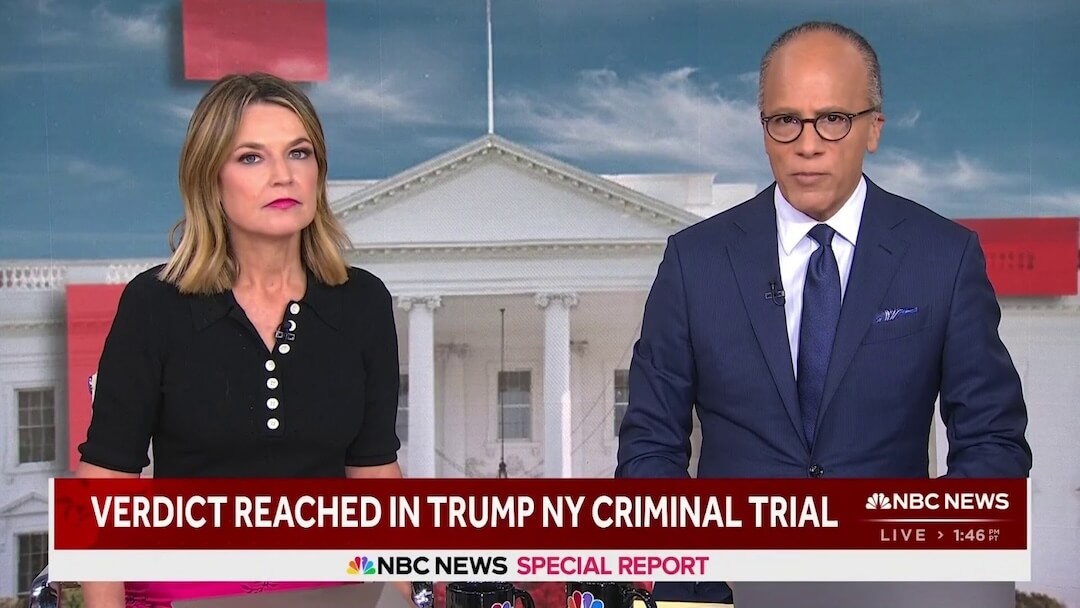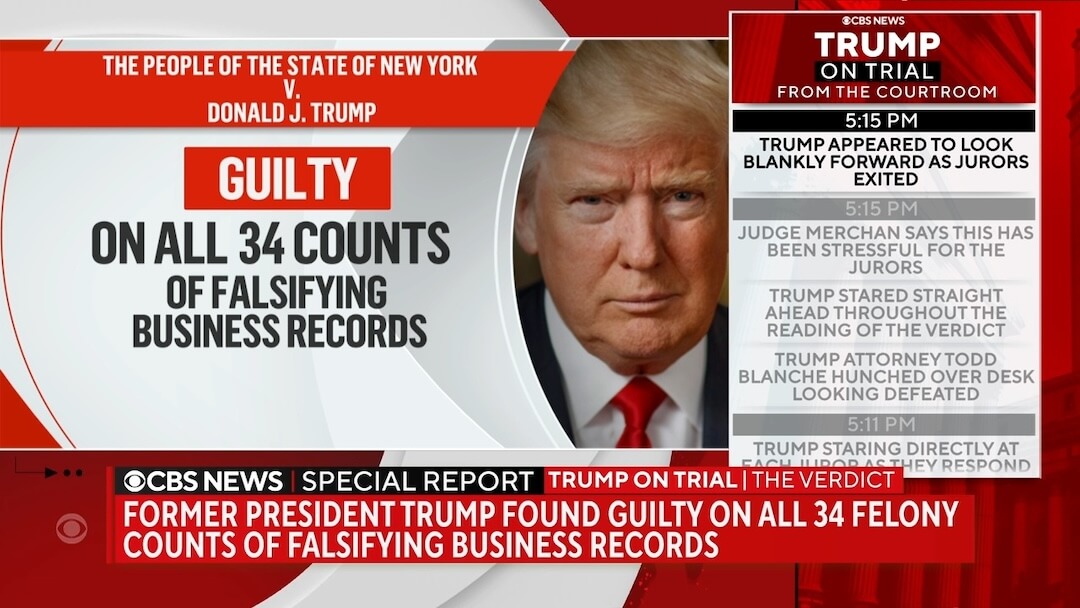The headlines were stunning.
The New York Times: “TRUMP GUILTY ON ALL COUNTS.”
The Washington Post had the exact same, except without the all caps: “Trump guilty on all counts.”
The Wall Street Journal: “Trump Guilty on All Counts in Hush-Money Case.”
The cover of the upcoming issue of The New Yorker has an illustration of Donald Trump, the former and perhaps future president of the United States, being placed in handcuffs.
On Thursday, Trump was found guilty on all 34 charges in what became known as the “hush money trial.” In short, Trump was convicted of falsifying records to cover up money he paid to a porn actress to keep their sexual liaison quiet. Trump became the first former president to be convicted of a felony.
The six-week trial went to the jury on Wednesday, and many assumed it could take days, if not weeks, for the jury to reach a verdict. It ended up taking hours — about nine and a half.
New York Times contributing opinion writer Jonathan Alter was in the courtroom when it was announced that the jury had reached a verdict. “You could hear a collective gasp in the courtroom,” he wrote.
That was nothing compared to the reaction across television and the country when we learned that the jury found Trump guilty on all 34 charges. NBC News had a counter on the screen counting up as Laura Jarrett, the network’s senior legal correspondent, announced each count followed by the word “guilty.”
As the numbers rolled from 1 to 2 to 3 and so on, it looked like the pump at a gas station while filling up your car.
MSNBC’s Rachel Maddow said on air, “He became the first president ever convicted of a felony. And then seconds later, the first president ever convicted of two felonies. Then every few seconds for a few minutes thereafter, he kept breaking his own brand-new old record for the most crimes any American president had ever been convicted of.”
When the counting stopped, Alter wrote a sentence almost too stunning to believe: “Trump had become a felon.”
CBS News chief Washington correspondent Major Garrett said on air, “To hear that word ‘guilty,’ not just once, but 34 times about a former president of the United States in any context is completely uncharted territory. … This is not just a legal moment for this country. It is not just a political moment for this country. It is a moment where everything about politics and law and our orientation to both are convulsed as never before.”
The Washington Post’s Jeremy Barr noted, “The television coverage lacked some of the drama of other big court cases, since the courts did not allow the trial to be broadcast, part of a broader slate of restrictions on media access. Instead of hearing the ruling from the jury, television viewers had it relayed to them via correspondents in the courthouse.”
Still, reports from the courtroom painted a good picture.
CBS News’ Katrina Kaufman, who was in the courtroom when the verdict was announced, said, “I was watching (Trump) as the verdict came down and he just had this very blank look on his face, his eyes were so squinted that it was almost hard to tell if they were even open during part of the time that the foreman was reading that he was guilty on each of these 34 charges.”
NBC News’ Hallie Jackson summed it up well: “I think it’s worth taking a beat here and recognizing that whether you like this verdict or not, this is an historic moment.”
Why it mattered
On Sunday, MSNBC will air “Prosecuting Donald Trump: Witness to History.” The show had been in the works before Thursday’s verdict. The show will air at 9 p.m. Eastern on MSNBC and will be streamed on Peacock the next day. It will feature NBC/MSNBC reporters, analysts and hosts — including Rachel Maddow, Andrew Weissmann, Joy Reid, Chris Hayes, Lawrence O’Donnell and Katie Phang.
Phang is a former trial lawyer who hosts a show on MSNBC. She was in the courtroom for some of the trial, and I had a chance to trade emails with her on Thursday. Our exchange was before and after the verdict.
Tom Jones: Some of Trump’s legal issues include what happened on Jan. 6, election integrity in Georgia, taking classified documents out of the White House. What makes this particular case — the hush money trial — so important?
Katie Phang: On its face, this trial is so important because it’s the first criminal trial of a former president of the United States. But, I actually refer to this trial as Trump’s “New York election interference trial” (and not his “hush money” trial) because that’s really what this case is all about: the fact that Trump had business documents falsified so that he could conceal his violation of New York election law through hush money payments, fake invoices, etc.
Before this trial, there was a lot of focus and attention on Trump’s classified documents case in Florida and his D.C. election interference case as it wound its way to the U.S. Supreme Court. There was a lot of activity going on in Trump’s Fulton County election interference case, too. So I think some people forgot about this case because it was on the back-burner of media attention for a while.
But, lo and behold, it was Manhattan DA Alvin Bragg who indicted Trump first and it ended up being Bragg who took him to trial first. And when we redirected our attention to this trial, and the prosecution’s theory better crystalized, we were able to see that Trump very well could have lost the 2016 election if this negative information had been revealed. But for the conspiracy he entered into with David Pecker and Michael Cohen to hide this info from the voting public, Trump might not have been the 45th president of the United States. It’s a pretty heady thought and that’s why this case is so important.
Jones: You have followed the trial more closely than most, including being in the courtroom. What has stood out to you? And what, in particular, has struck you that you might not have noticed had you not been in the courtroom?
Phang: Being inside of the courtroom is a different energy because you can feel the tension, see the emotions, and be an eyewitness to history in the making. It’s tragic that there is no video or audio that is able to be transmitted from inside of the courtroom so that the American public can also be a witness to this moment in history. One thing that you don’t get to see if you’re not inside the courthouse (either inside the courtroom or inside the media/public overflow room) is the image of Donald Trump slumped in his chair with his eyes closed, perhaps asleep, perhaps thinking. That is an impression that lasts: to see the former president of the United States as a criminal defendant at his counsel’s table during a trial, looking like he’s taking a nap.
The immediate aftermath
Trump, reportedly, did not react visibly in the courtroom to the verdicts, but he was defiant afterward, telling reporters outside the courtroom that he was a “very innocent man” and calling the trial “rigged” and “disgraceful.”
He is scheduled to be sentenced on July 11, and most assuredly will appeal. Trump also is expected to have another news conference today in New York.
Conservatives, including conservative media, blasted the verdicts and the trial.
According to The New York Times” Michael M. Grynbaum and John Koblin, Fox News on-air personality Jeanine Pirro said, “There is something that is very wrong here; we have gone over a cliff in America. … God help America after what I’ve seen in the last few weeks.”
Fox News’ Laura Ingraham said it was “a disgraceful day for the United States, a day America may never recover from.”
Meanwhile, over on MSNBC, host Nicolle Wallace said, “For me, the Trump story has always been about asymmetry … and when we learned that a verdict was in, our coverage would have been totally the same if he’d been acquitted. It would have been respect and reverence for Judge Juan Merchan, that we’ve all been articulating over the last several hours. It would have been respect and reverence for the jurors who said, ‘Yeah, pick me, I’ll do it.’ I think if there was criticism, it might have been, you know, that the process didn’t yield a result that seemed plain to our eyes, right?”
The coverage I particularly found useful was what happens next. The networks were at their strongest when they asked — and more importantly, answered — questions such as, “Will Trump go to jail?” and, “Can Trump still run for president?” (By the way, here’s a good explainer from PolitiFact’s Louis Jacobson and Samantha Putterman: “Trump guilty in NY trial: Can he still run for president or vote as a convicted felon?”)
But the coverage then struggled when facts turned to punditry, and there were wild predictions on what it all means.
CNN’s Jake Tapper probably put it best when he said, “For those wondering about the political consequences of these 34 guilty verdicts, the short answer is, nobody has any idea. Period.”
Here are a few notable links and tidbits regarding the Trump verdict

“Today” show co-host Savannah Guthrie and “NBC Nightly News” anchor Lester Holt anchored NBC News’ breaking news coverage of the Trump verdict. (Courtesy: NBC News)
- All three of the major TV networks — ABC, CBS and NBC — brought in their evening news anchors for the breaking news coverage.
- ABC News’ Nathaniel Rakich with “How Trump’s guilty verdict will impact the 2024 presidential election.”
- The New York Times editorial board with “Donald Trump, Felon.”
- The Washington Post’s Isaac Stanley-Becker with “Challenges await Trump jurors after ‘surreal experience.’”
- The Atlantic’s David Frum with “Wrong Case, Right Verdict.”
- Axios’ Stef W. Kight, Juliegrace Brufke and Stephen Neukam with “Pro-Trump right erupts after guilty verdict.”
- Semafor’s David Weigel with “A taxonomy of Republican rage against the Trump verdict.”
Wall Street Journal executes yet another round of layoffs
For this item, I turn it over to my Poynter colleague Angela Fu.
The Wall Street Journal laid off at least eight people Thursday, prompting the paper’s union to stage a lunchtime walkout.
The cuts included reporters on the paper’s U.S. News and breaking news teams, according to the union. Editor-in-chief Emma Tucker told staff in an email Thursday that the paper will be “moving away from regional and local general news” as it restructures those teams. The Journal will eliminate certain positions and reassign reporters to other desks, including a new national affairs team that will cover “big topics” like abortion, guns, race, immigration and land use.
“These changes mean that U.S. News will no longer be a standalone coverage area and that we are closing the East Coast, Mid-U.S. and West Coast regional bureaus,” Tucker wrote. “But it does not mean that we are pulling back from the United States. Far from it: Our economics team is expanding into new regions; the National Affairs reporters will be based all around the country, looking to tell stories of national consequence wherever they arise.”
A spokesperson for the Journal wrote in an emailed statement that Tucker is “reshaping our newsroom with an eye towards digital growth, subscription growth and high-quality journalism.” They did not answer a question about whether staff could expect more cuts this year.
“While we recognize change can be difficult, it is necessary to ensure we have the right structure in place to support our objectives,” the spokesperson wrote.
The Journal has had at least six other rounds of layoffs this year, resulting in more than 60 job cuts. In February, the outlet restructured its Washington, D.C., bureau, laying off 30 journalists, and later made cuts to its world team and several noneditorial departments. In March, the Journal laid off five editors from its standards and ethics team and a foreign correspondent. In April, the outlet cut 11 people, most of whom worked on the Journal’s video and social teams, and in May, the paper laid off eight journalists as it restructured its Hong Kong and Singapore bureaus.
Though financial pressures have caused dozens of other news outlets — including NBC News, the Los Angeles Times and Vice — to cut staff this year, the Journal has been adamant that its layoffs are not cost-cutting measures. Tucker wrote in her email to staff Thursday that both subscriptions and engagement have been up in recent months. The Journal is also currently recruiting for 37 vacancies.
The Dow Jones segment — which includes The Wall Street Journal — of parent company News Corp. recently ended its third quarter with an EBITDA (earnings before interest, taxes, depreciation and amortization) of $118 million, up 8% from the same period last year. It was the highest third quarter on record.
The piecemeal cuts have angered the union representing Dow Jones employees in the U.S. and Canada. Union members have questioned why the company continues to cut jobs while it experiences record revenues and subscriptions. On Thursday, members covered Tucker’s office with sticky notes during their lunchtime walkout to protest the layoffs.
And now onto other media news, tidbits and interesting links …
- Peter Alexander will fill in as guest moderator of NBC’s “Meet the Press” for the next several weeks. Regular moderator Kristen Welker will be on maternity leave. Welker is expected to be back in the moderator’s chair by the party national conventions later this summer. People’s Virginia Chamlee wrote two weeks ago about Welker and her husband expecting a child via surrogate.
- Some really good points made in this column from Mediaite by Isaac Schorr: “Trump’s Trial Has the Media Falling Back Into All of Its Worst Habits.”
- Variety’s Brian Steinberg with “CNN Will Buck Tradition and Put Commercial Breaks in Biden-Trump Presidential Debate.”
- Axios’ Sara Fischer with “X and NewsNation plan live town halls with Trump, RFK Jr.”
- For Slate, Bill Pruitt with “The Donald Trump I Saw on ‘The Apprentice.’”
- CNN’s Hadas Gold with “A national network of local news sites is publishing AI-written articles under fake bylines. Experts are raising alarm.”
- Bilge Ebiri, a film critic for New York and Vulture, with “Here’s the Real Reason Why There’s Still No Oscar for Best Stunts.”
- GQ’s Alex Kirshner with “Stephen A. Smith on the State of Sports Journalism, Touching the ‘Third Rail,’ and Whether He’s Underpaid.”
- One of the best sports columns I’ve read in quite some time — The Washington Post’s Jerry Brewer with “How Grievance Splintered American Sports.”
- For The New York Times, Grayson Haver Currin with “Sarah McLachlan Is Resurfacing.”
More resources for journalists
- Reporting on the Rise of AI: A RAND-Poynter Masterclass
- Subscribe to Poynter’s Friday newsletter, Open Tabs with Poynter managing editor Ren LaForme, and get behind-the-scenes stories only available to subscribers.
- Manage big responsibilities without direct reports? Try Lead With Influence.
- Understand U.S. Immigration From the Border to the Heartland — Start any time.
Have feedback or a tip? Email Poynter senior media writer Tom Jones at tjones@poynter.org.
The Poynter Report is our daily media newsletter. To have it delivered to your inbox Monday-Friday, sign up here.








